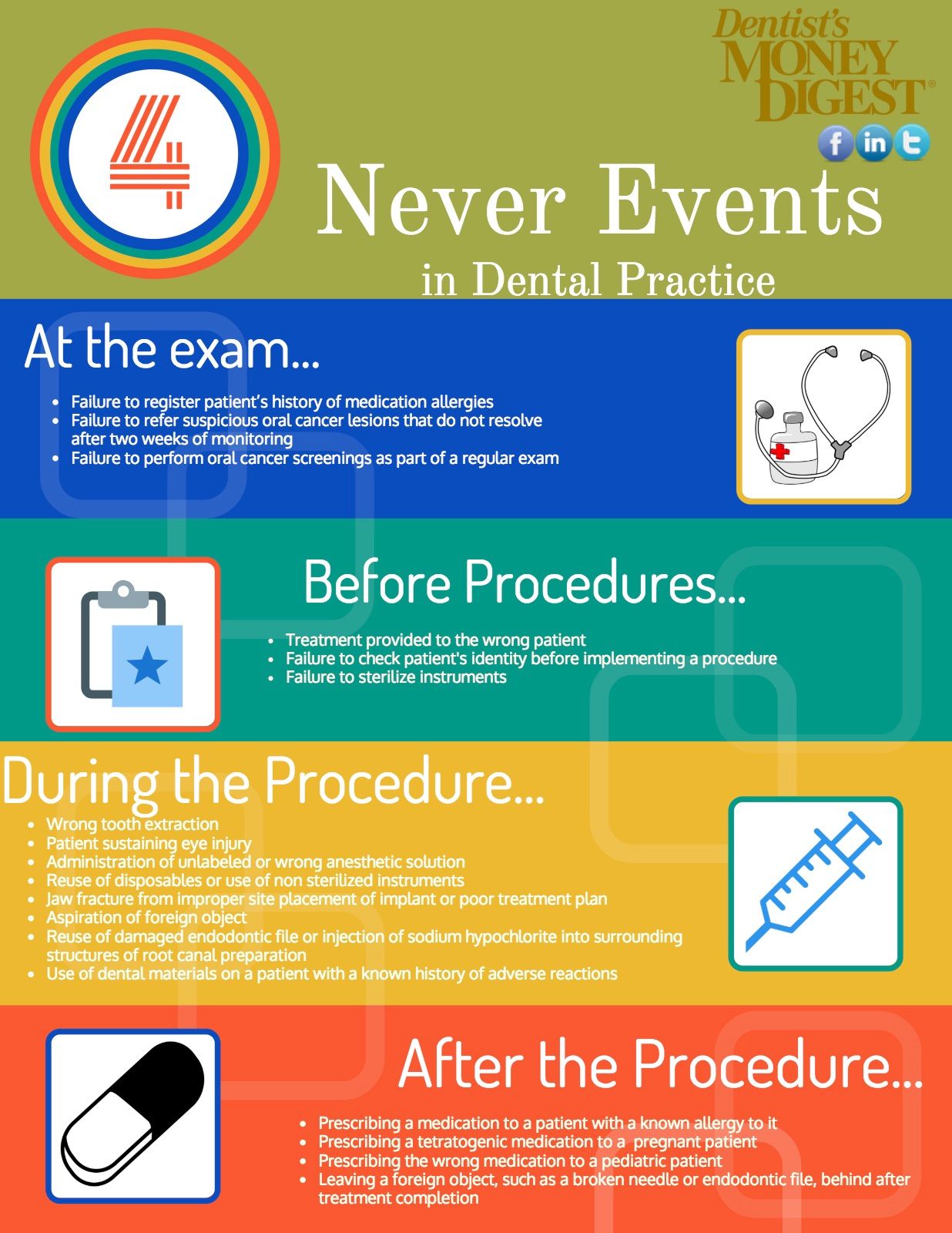Dentistry Finally Has Its Own List of Never Events
International consensus on the most preventable safety incidents in medicine is compiled into a list of so-called never events. Dental experts have recently gathered a similar list of the worst failures to occur in the practice of dentistry to help guide safety protocols.

Incidents known as “Never Events” (NEs) — severe healthcare failures by practitioners that should never occur under any circumstances – are well-established and internationally recognized in the medical commumity. Now, a recent study published in the British Dental Journal has compiled similar guidelines surrounding NEs in dental practice.
Previously, there had been no international agreement in the dental community about NEs in patient care. “By listing a consensus position on never events in dentistry, we hope that regulators and professional bodies will be able to assess the frequency of such events and reduce their occurrence,” said Professor Aziz Sheikh, the project lead and director of the University of Edinburgh’s Usher Institute of Population Health Sciences and Informatics.
Examples of NEs in medicine include performing surgery on the wrong part of the body or leaving surgical instruments in the bodily cavity. The dental list includes failures at the diagnostic and surgical levels, too. Many, if not all, of the NEs on the list come as no surprise to practicing dentists who strive to reduce all adverse events in their dental practice. Awareness of the new list, however, is a good reminder of safety practices learned in dental school. Reviewing the dental NEs routinely can help clinicians remain diligent in their safety protocols, and avoid bringing undue costs and frustration into their practice.
Methods of Data Collection
Surveys were distributed to participants from many countries with different educational, experience and specialty backgrounds. Initial NEs included on the survey were selected by evaluating NEs for general hospital care, common failures seen in dental safety reports and issues reported in recent dental literature. Primary and secondary rounds of surveys were distributed to participants, with the second survey including more crucial inclusions written in by primary survey participants. NEs in dentistry are broken down into four categories by treatment phase including: routine assessment, preoperative stage, intraoperative stage, and post-operative stage.
Routine Assessment
Failures at this level happen when basic practices performed routinely by both the hygienist and the dentist are neglected. Failure to record patient medication changes or allergies received the greatest consent among professionals as the worst NE at this level. Other NEs include not performing oral cancer assessments and failure to refer possible oral cancer lesions for evaluation.
Preoperative Stage
NEs at the preoperative level are related to rendering the wrong treatment to a patient or failing to check the patient’s identity before proceeding with treatment. Additionally, failure to sterilize reusable instruments ranks as an important NE.
Intraoperative Stage
This treatment level includes the most comprehensive section of the list naming thirteen NEs, with majority consensus for treating the wrong tooth. Using the wrong injectable anesthetic, or using an unlabeled cartridge, both rank on the list because of their potential to cause adverse events. Jaw fractures associated with improper, or misplaced, implant procedures rank as important NEs as well as safety concerns including eye injuries due to lack of protective eye wear, aspiration of any materials and injection of sodium hypochlorite into surrounding structure of the root canal.
Post-operative Stage
Post-operative failures mainly include improperly prescribing medications to vulnerable populations such as pregnant women, children and people with allergies. Retained foreign objects, like broken needles or root canal files, also make the list.
A comprehensive list of NEs for the dental community is a much-needed addition to continuing education on patient safety protocols. Sheikh hoped NEs are incorporated into the dental awareness as a “vital way to flag failures in procedure that put patient safety at risk.” Ensuring the entire dental team monitors appointments for these failures can take the headache out of unwanted, preventable treatment complications down the road.
Click here to sign up for more Dentist's Money Digest content and updates.
RELATED: More Coverage on
- How Referring Endodontic Treatments to a Specialist Will Save You Money
- Want to Be the Go-To Dentist? Start By Understanding Who You Are
- Dangerous Influences During Implant Procedures and How to Avoid Them
ACTIVA BioACTIVE Bulk Flow Marks Pulpdent’s First Major Product Release in 4 Years
December 12th 2024Next-generation bulk-fill dental restorative raises the standard of care for bulk-fill procedures by providing natural remineralization support, while also overcoming current bulk-fill limitations.